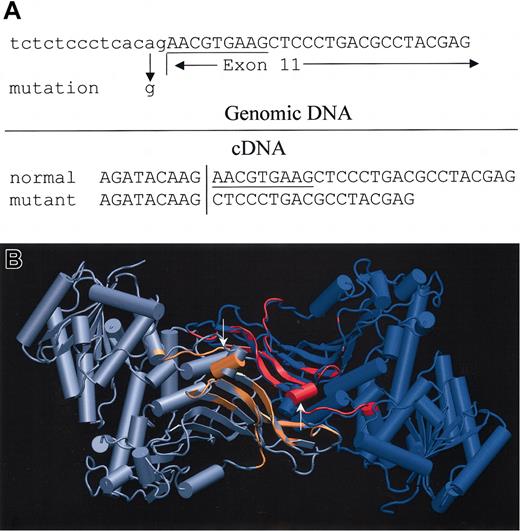Glucose-6-phosphate dehydrogenase (G6PD) deficiency is the most common hereditary enzymopathy, affecting an estimated 400 million people worldwide with some 140 known molecular G6PD defects.1,2 Adeficient variant from Switzerland, designated “G6PD Zurich,” was found to have an unusual mechanism of producing enzyme deficiency, a splice site mutation that resulted in an in-frame deletion of 3 amino acids.
Sequencing of genomic DNA from the 33-year-old Swiss male patient revealed a single nucleotide mutation that altered IVS10(-2) from the consensus a to g. Using a 5′ primer at the junction of exons 9/10 and 2 different 3′ primers in exon 11 and the junction of exons 11/12, polymerase chain reaction (PCR) was performed to amplify cDNAs made from the mRNA of peripheral blood mononuclear cells of the patient, his mother, and a healthy control. As shown in Figure 1A, alternative splicing removed the first 9 nucleotides of exon 11 (AAC GTG AAG). These nucleotides code for the amino acids Asn, Val, and Lys at positions 430 to 432.
Point mutation in and molecular modeling of G6PD Zurich. (A) Point mutation in G6PD Zurich that leads to alternative splicing and a 9-base deletion. In the cDNA, the exon to the left of the vertical line is exon 10. Exon 11 is shown on the right side. (B) Molecular modeling of G6PD Zurich. G6PD wild type (WT) versus Zurich: an overlap of the wild type (blue and gray) and Zurich mutant (red and orange) structures reveals a change in a loop and an adjacent helix forming part of the substrate binding site. The active Lys205 (shown in CPK) is in direct proximity. The mutation affects helix of the substrate binding site in both monomers (arrows) but only minimally affects the dimer interface. The figures were created with VMD software8 (http://www.ks.uiuc.edu/Research/vmd) and rendered with Povray (http://www.povray.org).
Point mutation in and molecular modeling of G6PD Zurich. (A) Point mutation in G6PD Zurich that leads to alternative splicing and a 9-base deletion. In the cDNA, the exon to the left of the vertical line is exon 10. Exon 11 is shown on the right side. (B) Molecular modeling of G6PD Zurich. G6PD wild type (WT) versus Zurich: an overlap of the wild type (blue and gray) and Zurich mutant (red and orange) structures reveals a change in a loop and an adjacent helix forming part of the substrate binding site. The active Lys205 (shown in CPK) is in direct proximity. The mutation affects helix of the substrate binding site in both monomers (arrows) but only minimally affects the dimer interface. The figures were created with VMD software8 (http://www.ks.uiuc.edu/Research/vmd) and rendered with Povray (http://www.povray.org).
Using Moloc software (Gerber Molecular Design, Amden, Switzerland; http://www.moloc.ch), the dimeric wild-type structure was constructed from the G6PD Canton mutant available in the Protein Data Bank (PDB, http://www.rcsb.org/pdb/) (PDB code 1QKI).4 The G6PD Zurich mutant was then modeled from the wild type. Energy minimization was done at each step to a final root-mean square gradient of 0.1 kcal/mol/Å using the MAB all atom force field.5 These studies predict a significant structural change in a loop of the substrate binding site (Figure 1B). A lysine at the end of the conserved amino acid sequence DHYLGK (residues 200 to 205, PROSITE entry PS00069, http://www.expasy.org/cgi-bin/nicedoc.pl?PS00069) represents as a reactive nucleophile associated with enzyme activity.6 This lysine is in direct proximity of the distorted loop. Additionally, an α-helix adjacent to the deleted amino acids is rotated relative to its original position. It is likely that the Zurich mutation disrupts the substrate binding site, slowing the rate of the enzyme reaction. In contrast, the structural change does not interfere significantly with the dimer interface.
The vast majority of mutations in the G6PD gene are missense mutations. To the best of our knowledge, there is only one missplicing mutation described previously. G6PD Varnsdorf7,8 destroys the same obligate splice site as is destroyed in G6PD Zurich. However, it is not the same mutation. In G6PD Varnsdorf, the invariant 3′ ag dinucleotide has been deleted; in G6PD Zurich, a point mutation has mutated the ag to gg. In the G6PD Zurich as in G6PD Varnsdorf, the next available downstream consensus splice sequence was used resulting in deletion of 3 amino acids. It is probably no coincidence that the only 2 splicing mutations in G6PD discovered so far both affect the same splice site. Since null mutations of G6PD appear to be incompatible with life, a functional alternative splice site that does not cause a frameshift is required for viability. The 3′ splice site of intron 10 offers this opportunity.
Supported by National Institutes of Health grant DK061370 and the Stein Endowment Fund.


This feature is available to Subscribers Only
Sign In or Create an Account Close Modal